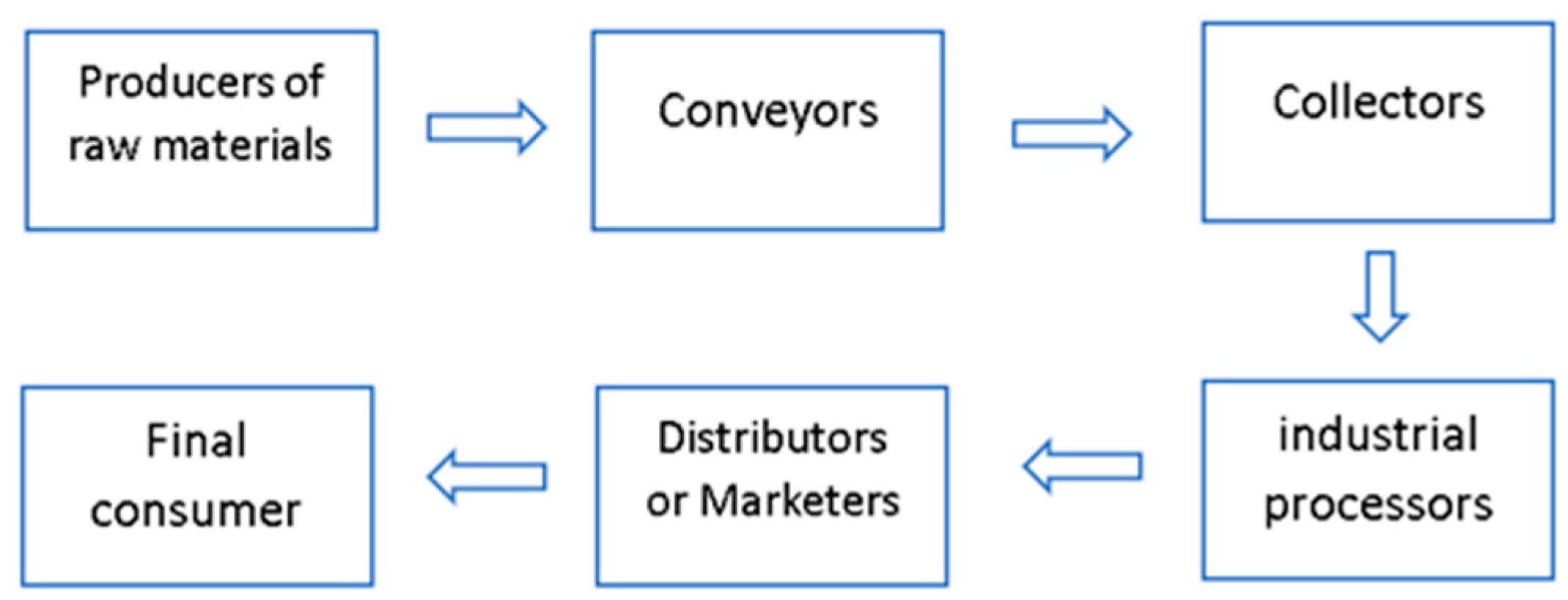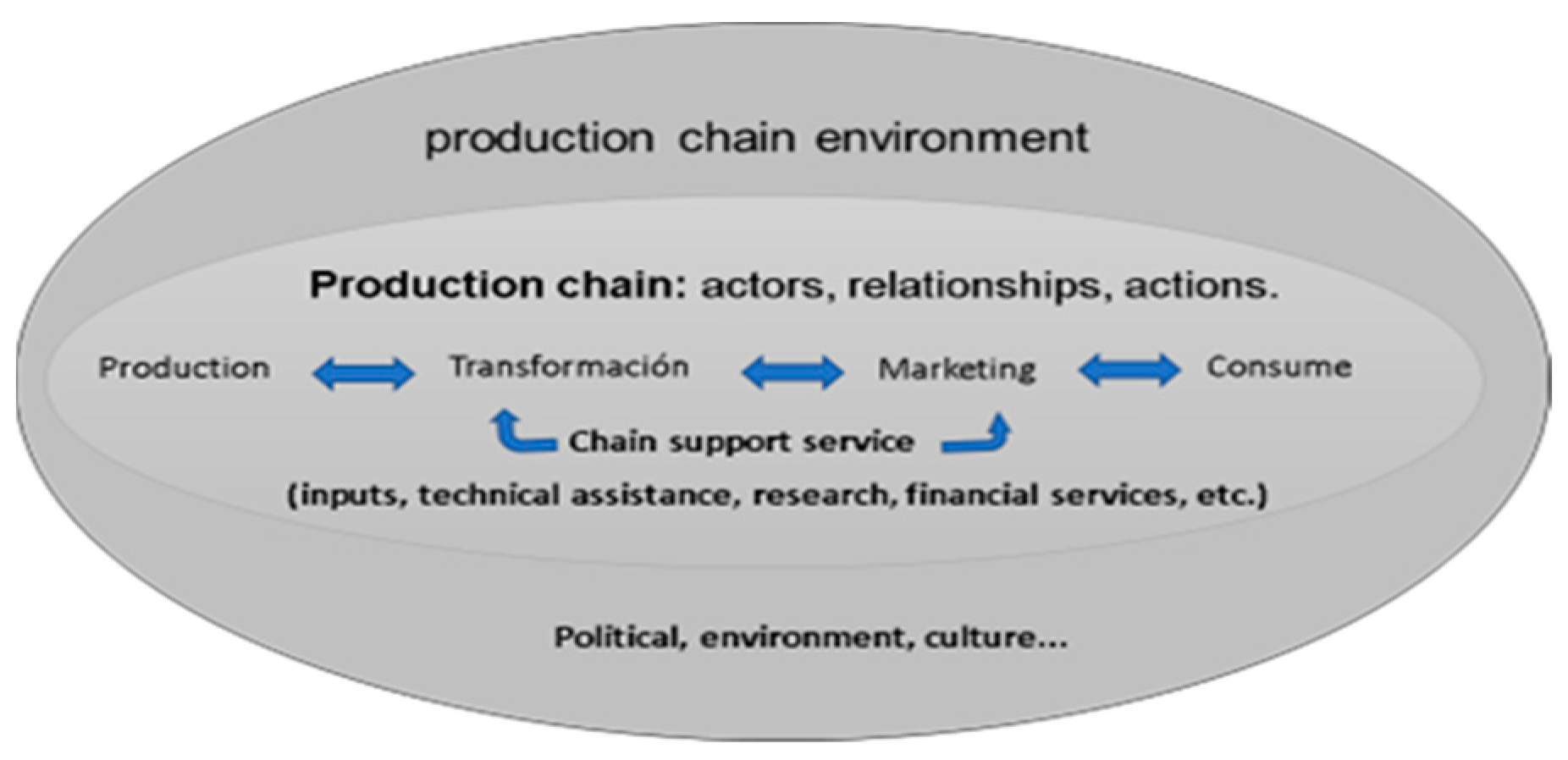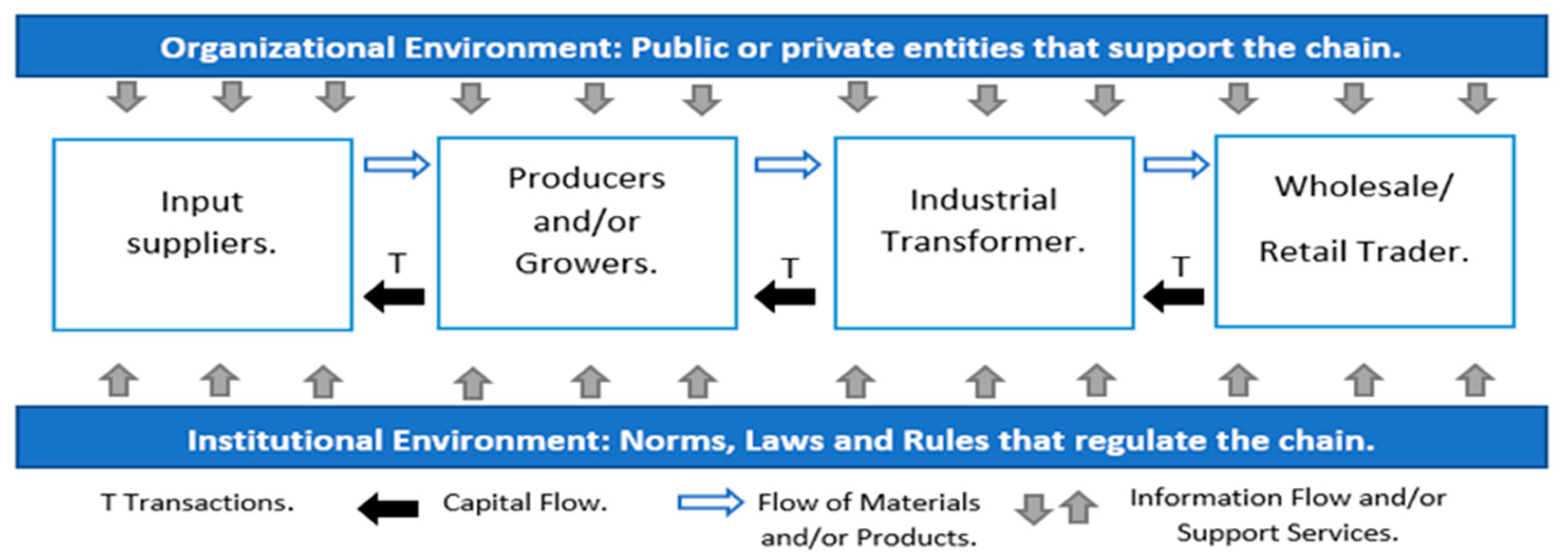You're using an outdated browser. Please upgrade to a modern browser for the best experience.

Submitted Successfully!
Thank you for your contribution! You can also upload a video entry or images related to this topic.
For video creation, please contact our Academic Video Service.
| Version | Summary | Created by | Modification | Content Size | Created at | Operation |
|---|---|---|---|---|---|---|
| 1 | Jose Aguilar | -- | 1140 | 2024-02-19 10:58:32 | | | |
| 2 | Jessie Wu | + 25 word(s) | 1165 | 2024-02-20 01:56:57 | | |
Video Upload Options
We provide professional Academic Video Service to translate complex research into visually appealing presentations. Would you like to try it?
Cite
If you have any further questions, please contact Encyclopedia Editorial Office.
Fuentes, J.; Aguilar, J.; Montoya, E.; Pinto, �. Definition of Autonomous Cycles for the Agroindustrial Sector. Encyclopedia. Available online: https://encyclopedia.pub/entry/55161 (accessed on 28 December 2025).
Fuentes J, Aguilar J, Montoya E, Pinto �. Definition of Autonomous Cycles for the Agroindustrial Sector. Encyclopedia. Available at: https://encyclopedia.pub/entry/55161. Accessed December 28, 2025.
Fuentes, Jairo, Jose Aguilar, Edwin Montoya, Ángel Pinto. "Definition of Autonomous Cycles for the Agroindustrial Sector" Encyclopedia, https://encyclopedia.pub/entry/55161 (accessed December 28, 2025).
Fuentes, J., Aguilar, J., Montoya, E., & Pinto, �. (2024, February 19). Definition of Autonomous Cycles for the Agroindustrial Sector. In Encyclopedia. https://encyclopedia.pub/entry/55161
Fuentes, Jairo, et al. "Definition of Autonomous Cycles for the Agroindustrial Sector." Encyclopedia. Web. 19 February, 2024.
Copy Citation
One of the great current challenges of Micro, Small and Medium Enterprises (MSMEs) is to dynamically innovate to improve their supply of goods, products, and services in order to respond to the changing needs of the market. In particular, several studies have concluded that investment in innovation has a high impact on the competitiveness of organizations, which can lead to the introduction of new products and processes. Thus, innovation is a means for companies to adapt to remain in the market, considering available resources.
production-chain
agroindustry
autonomous computing
artificial intelligence
1. Application of Methodology for the Specification of Data Analytics Tasks to the Agroindustrial Production Chain of Small and Medium Enterprises
Table 1 summarizes the use of the methodology for the specification of data analytics tasks (MIDANO) to analyze the agroindustrial production chain of Small and Medium Enterprises (MSMEs).
Table 1. Use of MIDANO phases for Industrial Automation Processes.
| Phase | Use |
|---|---|
| Phase 1 | Analysis of the production chain in the agroindustrial to improve their competitiveness. To this end, this research proposes ACODAT to improve industrial production. |
| Phase 2 | Identification of data sources (e.g., quantity, quality, time, and cost). |
| Phase 3 | Implementation of autonomic cycles for the automation of the production chains in agroindustry. |
2. Agroindustrial Production Chain of Small and Medium Enterprises
Based on an analysis of agribusiness, it is possible to establish the macro conditions under which the production chains operate. In general, there is a wide range of activities and, therefore, actors that are part of a chain. It is, therefore, necessary to clearly establish the limits of the production chain and define its operating structure by establishing a model. The work [1] proposes a production chain model (see Figure 1), the basis of researchers' proposal.

Figure 1. Production chain links (source: United Nations Industrial Development Organization).
In this context, Nonaka [2] has defined a scheme of the production chain and its main actors (see Figure 2).

Figure 2. The production chain and its actors (source [2]).
As a starting point from such a model, it is necessary to understand the framework of production chains and establish how they are conceived, what their constituent elements are, and what characteristics they should have. The steps to follow to properly model a production chain are summarized below [3][4].
-
Establish the links in the production chain (defined by the blue arrows in Figure 2).
-
Determine the segments that make up each of the links in the production chain by using segmentation instruments and their corresponding variables.
-
Represent the material and capital flows that take place in the chain.
-
Establish the institutional and organizational environment of the chain.
The above activities must be accompanied by a validation by the chain actors. For the construction of the proposal, 15 experts from the MSME agribusiness sector validated each of the links in the production chain. Figure 3 shows researchers' proposal of an Agroindustrial Production Chain for MSMEs.

Figure 3. Researchers' Proposal of an Agroindustrial Production Chain for MSMEs.
Researchers' proposal has four processes (see Table 2): Input Suppliers, Producers and/or Growers, Industrial Transformer and Marketing.
Table 2. Processes in researchers' agroindustrial production chain.
| Process | Examples |
|---|---|
| Suppliers of Input Materials | Irrigation systems, organic and inorganic fertilizers, certified seeds. |
| Producers and/or Growers | Land tenure, area, labor force, technological level, degree of specialization, market share, working capital, forestry support services, agricultural support activities, post-harvest activities, seed processing. |
| Industrial Transformer | Size of the property, labor force, type of input to be processed, quality parameters, technological level, the added value of the product, market scope and coverage, level of specialization of the business. |
| Wholesaler/Retailer | Stockpiling and Distribution. Storage, Classification, Standardization, Packaging and Transportation. |
-
Input Suppliers: the entities that provide or supply certain products or services to companies for their use, for example, agrochemicals and packaging.
-
Producers and/or Growers: this process is in charge of the harvest and post-harvest preparation. It must consider, among other things, the workmanship, the forestry support services and post-harvest activities.
-
Industrial Transformer: this process transforms or adapts the inputs for the materialization of the intended products or services. It must consider, among other things, The type of input to be transformed, the technology required for the transformation, etc.
-
Wholesaler/Retailer Commercialization: this process is the distribution of products or services to the market. It must consider, among other things, stockpiling and marketing.
Each process of the Agroindustrial Production Chain of MSMEs has different subprocesses, which should be prioritized according to whether data analysis tasks can be used and what its relevance is to improve the competitiveness of an MSME in the agroindustrial sector. Researchers identify 15 subprocesses, listed in Table 3.
Table 3. Subprocesses in the Agroindustrial Production Chain of MSMEs.
| Process | Subprocess | ACRONYM |
|---|---|---|
| Input suppliers |
Certified seeds | SCS |
| Organic and inorganic fertilizers | AOEI | |
| Primary, secondary and tertiary packaging | EPST | |
| Applications of agrochemicals in particular and fertilizers. | AAPF | |
| Producers and/or growers |
Workmanship | MOEP |
| Forestry support services | SAAF | |
| Post-harvest activities | APAC | |
| Technological level | NTAP | |
| Industrial transformer |
Type of input to be processed | TIAT |
| Transformer technology level | NTAT | |
| Market reach and coverage. | ACDM | |
| Level of business specialization. | NEDN | |
| Wholesaler/retailer commercialization |
Stockpiling | ACOP |
| Leveling | NIVE | |
| Distribution | DIST |
3. Prioritization of Subprocesses of the Agroindustrial Production Chain of MSMEs
A prioritization table has been used to select the subprocesses. The criteria to evaluate the relevance of the subprocesses were defined according to the importance of each subprocess in the MSME Agroindustrial Production Chain, and the possibility of performing data analysis tasks. Thus, these values determine the level of importance of each subprocess (see Table 4).
Table 4. Evaluation metrics.
| Meaning | Weight |
|---|---|
| Subprocess is not important | 1 |
| Subprocess is slightly important | 2 |
| Subprocess is important | 3 |
| Subprocess is very important | 4 |
For the construction of the prioritization table, 15 experts in the MSME Agroindustrial sector, and 10 research professors rated each of the criteria. In the result, each of the answers provided by them was averaged. The results are shown in Table 5, where the columns with the numbers in red represent the subprocesses with the highest priority (they represent the highest scores), for which the ACODATs are proposed in this research.
Table 5. Prioritized subprocesses by experts.
| Weight | Evaluation Criteria | Processes | ||||||||||||||
|---|---|---|---|---|---|---|---|---|---|---|---|---|---|---|---|---|
| Input Suppliers | Producers and/or Growers | Industrial Transformer | Wholesaler/Retailer | |||||||||||||
| SCS | AOEI | EPST | AAPF | MOEP | SAAF | APAC | NTAP | TIAT | NTAT | ACDM | NEDN | ACOP | NIVE | DIST | ||
| Relevance to Production Management | ||||||||||||||||
| 4 | the factors that intervene in the process are characterized. | 4 | 3 | 2 | 4 | 3 | 3 | 4 | 4 | 4 | 4 | 4 | 4 | 3 | 3 | 4 |
| 4 | the uses and functions of the materials and tools used are distinguished | 3 | 4 | 3 | 4 | 2 | 2 | 4 | 4 | 4 | 4 | 4 | 3 | 2 | 3 | 3 |
| 4 | information and knowledge management is identified | 2 | 3 | 3 | 4 | 2 | 3 | 3 | 4 | 4 | 4 | 4 | 4 | 2 | 3 | 4 |
| 4 | Production, service and support processes are identified. | 2 | 4 | 3 | 4 | 3 | 4 | 4 | 4 | 4 | 4 | 4 | 3 | 2 | 3 | 4 |
| 4 | Environmental responsibility, good use and conservation of biodiversity. | 3 | 4 | 4 | 4 | 2 | 4 | 4 | 3 | 4 | 4 | 4 | 4 | 2 | 3 | 3 |
| 4 | Machinery capacity | 2 | 3 | 4 | 4 | 2 | 3 | 3 | 3 | 4 | 4 | 3 | 4 | 3 | 3 | 2 |
| 4 | Accessibility to technology. | 3 | 3 | 4 | 2 | 2 | 3 | 3 | 4 | 4 | 4 | 4 | 4 | 3 | 3 | 4 |
| 4 | Skilled Labor (Requirement and Availability) | 4 | 3 | 3 | 2 | 4 | 2 | 3 | 4 | 4 | 4 | 4 | 4 | 3 | 3 | 4 |
| 4 | Identification of suppliers of raw materials and inputs (domestic, international origin) | 4 | 4 | 4 | 3 | 2 | 3 | 3 | 2 | 4 | 4 | 4 | 4 | 4 | 3 | 4 |
| Relevance for performing data analysis tasks | ||||||||||||||||
| 4 | How many internal or external sources of information exist: databases, Excel sheets, reports, etc. | 3 | 3 | 4 | 3 | 3 | 3 | 3 | 4 | 3 | 4 | 4 | 4 | 4 | 3 | 4 |
| 4 | What level of access do you have to the information | 4 | 3 | 3 | 4 | 3 | 2 | 4 | 4 | 3 | 4 | 4 | 4 | 4 | 3 | 4 |
| 4 | Level of use of computer tools (Words, excel, power point, etc.). | 2 | 3 | 3 | 3 | 3 | 2 | 3 | 4 | 3 | 3 | 4 | 3 | 4 | 3 | 4 |
| 4 | Frequency of information gathering at this stage of the process | 3 | 3 | 3 | 3 | 3 | 3 | 3 | 4 | 3 | 3 | 4 | 4 | 4 | 3 | 4 |
| Total unweighted | 39 | 43 | 43 | 44 | 34 | 37 | 44 | 48 | 48 | 50 | 51 | 49 | 40 | 39 | 48 | |
| Weighted total | 36 | 36 | 37 | 39 | 37 | 33 | 38 | 39 | 42 | 41 | 38 | 41 | 37 | 36 | 38 | |
From the above table, the subprocesses “Type of Input to Transform”, “Transforming Technological Level” and “Business Specialization Level” were the highest prioritized.
References
- Ramírez-Valverde, B. “Gerardo Torres Salcido y Rosa María Larroa Torres (coord): Sistemas agroalimentarios localizados: Desarrollo conceptual y diversidad de situaciones” (Reseña). Agric. Soc. Desarro. 2013, 10, 133–137.
- Nonaka, I. The knowledge creating company. Harv. Bus. Rev. 1991, 85, 162–171.
- Castellanos, O.; Rojas, J. Conceptualización y papel de la cadena productiva en un entorno de competitividad. Innovar 2001, 18, 87–98.
- Fletes, H.; Ocampo, G.; Valdiviezo, G. Agroindustry dynamism in the Corredor Costero, Chiapas, Mexico. Coordination and territorial competitivity. Mundo Agrar. 2016, 17, e038.
- Flórez, D. Prospective research guidelines for the production chain of sugarcane—(focus on panela, not centrifuged sugar). Tecnura 2013, 17, 72–86.
- García, E.; Vieira, M. Estudo de caso de mineração de dados multirelacional: Aplicação do algoritmo connetionblock em um problema da agroindústria. In Proceedings of the Simpósio Brasileiro de Bancos de Dados, Campinas, Brazil, 13–15 October 2008; pp. 224–237.
- Organización de Cooperación y Desarrollo Económicos, ocde. Manual de Oslo: Guía Para la Recogida e Interpretación de Datos Sobre Innovación, 3rd ed.; Traducción española Grupo Tragsa: Madrid, España, 2005; p. 188.
- Salimbeni, S.; Redchuk, A.; Rousserie, H. Quality 4.0: Technologies and readiness factors in the entire value flow life cycle. Prod. Manuf. Res. 2023, 11, 2238797.
More
Information
Subjects:
Automation & Control Systems
Contributors
MDPI registered users' name will be linked to their SciProfiles pages. To register with us, please refer to https://encyclopedia.pub/register
:
View Times:
445
Revisions:
2 times
(View History)
Update Date:
20 Feb 2024
Notice
You are not a member of the advisory board for this topic. If you want to update advisory board member profile, please contact office@encyclopedia.pub.
OK
Confirm
Only members of the Encyclopedia advisory board for this topic are allowed to note entries. Would you like to become an advisory board member of the Encyclopedia?
Yes
No
${ textCharacter }/${ maxCharacter }
Submit
Cancel
Back
Comments
${ item }
|
More
No more~
There is no comment~
${ textCharacter }/${ maxCharacter }
Submit
Cancel
${ selectedItem.replyTextCharacter }/${ selectedItem.replyMaxCharacter }
Submit
Cancel
Confirm
Are you sure to Delete?
Yes
No




